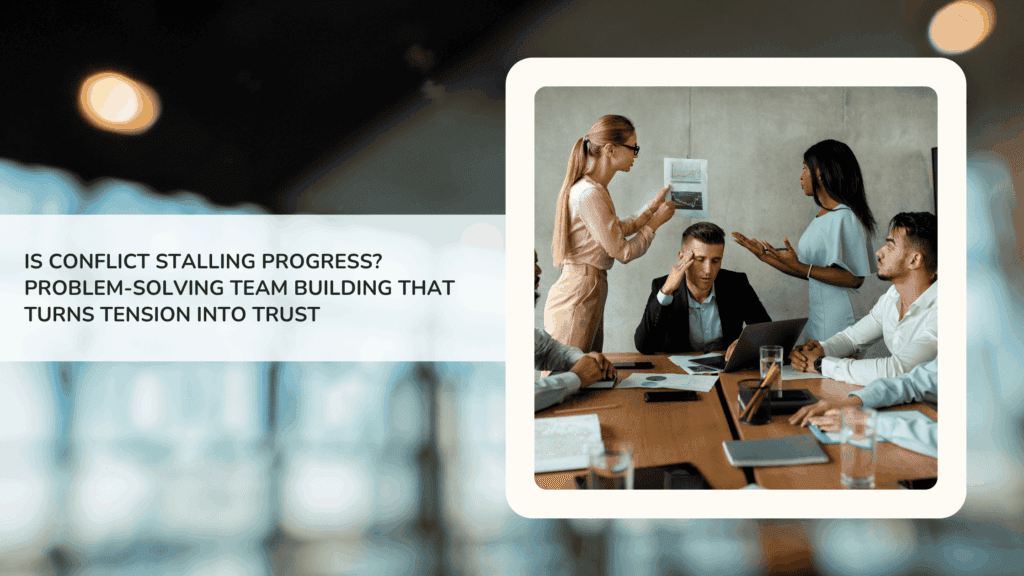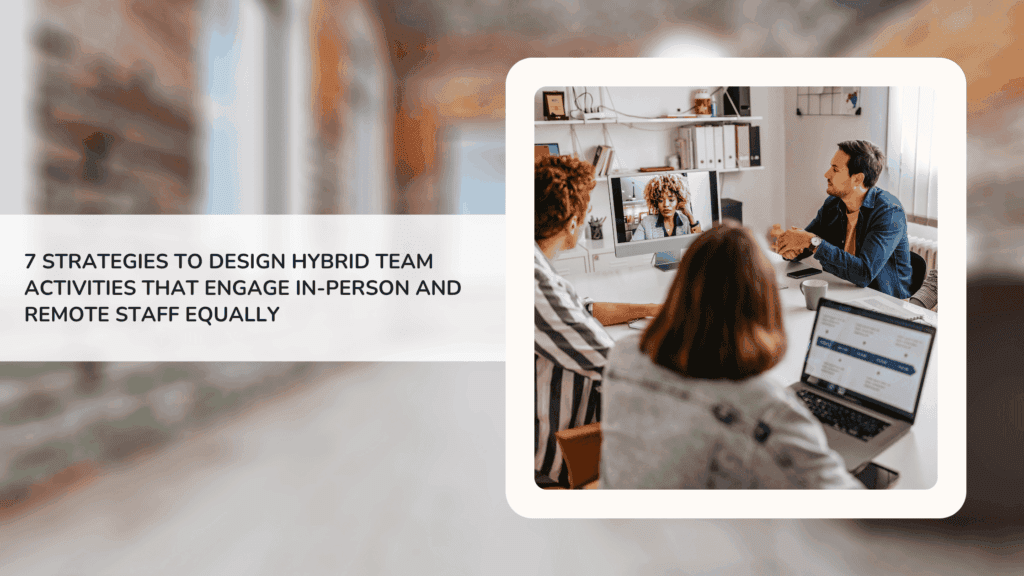Mental health-focused team building sends a loud message about your company’s values. It shows your team they’re not productivity machines. They’re real people who matter.
If you’re ready to help your employees feel seen, valued, and supported to thrive, keep reading.
In this short guide, we share eight mental health-focused team building activities that encourage better emotional well-being and resiliency at work.
Let’s take a look!
Table of Contents
- 1. Guided group meditation or mindfulness sessions
- 2. Team resilience workshops
- 3. Small-group emotional check-ins
- 4. Mental health storytelling panels
- 5. Guided gratitude and compassion practices
- 6. Stress-relief art sessions
- 7. Collaborative mental health challenges
- 8. Mental health first aid training
- How to implement mental health-focused team building activities that support your employees
- Wrap up
- Author Bio
1. Guided group meditation or mindfulness sessions
Bring in a trained meditation coach to guide your team through stress-relieving practices, such as breathing exercises, progressive muscle relaxation, or visualization. Or bring in a travel physical therapist to run fun stretch and movement sessions. (Physical activity is a great option if your employees sit down most of the day.)
2. Team resilience workshops
Hire a licensed mental health professional or resilience trainer to run workshops on coping with change, managing emotional triggers, or bouncing back from setbacks.
Consider theming each session around your team’s real workplace challenges, like handling conflict or navigating uncertainty.
3. Small-group emotional check-ins
Set up regular, voluntary small-group check-ins where employees can talk about stress, burnout warning signs, and wins in a low-pressure environment. You could also create peer-led Mental Health Circles where the goal is to listen without fixing or judging.
4. Mental health storytelling panels
Host internal panels where employees or leaders share personal stories about mental health challenges they’ve faced and how they navigated them.
Call it the “Stronger Together” series.
5. Guided gratitude and compassion practices
Run a team session focused on practicing gratitude and compassion together.
You could start by writing thank-you notes to coworkers, journaling based on gratitude prompts, and engaging in guided visualizations that foster self-compassion.
6. Stress-relief art sessions
Set up a no-pressure art team activity designed for emotional expression, such as collaborative mural painting, watercolor sessions, or simple doodling hours.
Or, host “Create to Recharge” afternoons where the goal isn’t artistic skill. It’s an emotional release. (A great option if you have an outdoor space at the office.)
7. Collaborative mental health challenges
Create light, low-stress mental wellness challenges that encourage teams to work together and win.

Or launch a “7-Day Stress Reset” where teams earn points for group activities, such as five-minute meditations, midday screen breaks, or gratitude shout-outs.
8. Mental health first aid training
Offer team-based mental health first aid courses that teach employees how to recognize signs of anxiety, depression, and burnout in coworkers. (And how to offer early support.)
*Pro-Tip: Certify your managers and volunteer peer supporters through reputable programs like Mental Health First Aid USA.
How to implement mental health-focused team building activities that support your employees
The ideas above are great, but it’s also important to get buy-in from your team. They’re the ones participating in the activities, and they deserve to have a say when it comes to their well-being.
Here are some ways you can implement mental health-focused team building activities that align with employee preferences:
Audit your current team building practices
Look at your current team building events through a mental health lens. (Sometimes the stuff meant to help is actually stressing people out.)
Audit everything. Are you hosting high-energy games that drain introverts? Long Zoom sessions that zap remote workers? If so, swap them for low-key, mental health-friendly options. To excel in managing remote teams, you must embrace a new mindset, adopt innovative management approaches, and keep employees motivated and productive. Get your employees involved to understand what to focus on.
Speaking of which …
Survey employees anonymously
Create an anonymous survey and include questions like, “What types of wellness activities would feel safe and helpful to you?” and “What do you wish leadership understood about mental health?”
This provides you with real insights that you can use to build programs people will want to join.
You can also track attendance and survey your team after activities to see what makes a difference. For example, after hosting a financial wellness workshop about what to do about student loan debt, you might notice a huge drop in financial stress scores on your surveys.
In this case, hosting themed financial wellness workshops on a regular basis could be a smart and supportive move.
Create opt-in participation policies
No one should feel forced to participate in mental health initiatives.
Make every event clearly opt-in, and communicate that there’s no judgment for passing. You could add simple language like, “Join if it feels supportive for you!” to every invite to set the tone.
Note that if there’s a session you think the entire team could benefit from, consider asking an employee who has attended to provide a quick testimonial. It could be the nudge everyone else needs to give it a try.
Include trained facilitators or licensed professionals
Never hand mental health program facilitation to an untrained manager or volunteer. Hire licensed therapists, certified mindfulness coaches, or mental health educators to lead sessions.
For example, consider bringing in a therapist for a guided group resilience workshop instead of relying on HR to handle it.
More on licensed professionals soon.

Tie activities to real systemic change
Activities are helpful, but it’s also important to link initiatives to more company-wide benefits. (Like flexible hours, no-meeting Fridays, mental health days, or expanded counseling services.)
Take this a step further by giving employees access to a telehealth app for wellness check-ins and prescriptions. Additionally, if possible, a gym stipend or the option to work with a nutrition coach.
Build recovery time into schedules
Give people time to decompress before and after emotionally focused sessions or vulnerable team check-ins. Block off at least 30 minutes after a mental health workshop for reflection or quiet work.
Wrap up
You can’t fix burnout with a gratitude circle alone. You need real programs backed by flexible policies, professional facilitators, and constant feedback from your team.
When you build team-building programs with your employees, instead of “for” them, you inspire trust, loyalty, and a positive work environment where people thrive.
PS: Need help facilitating team building activities? Request a quote from Outback Team Building now.
Author Bio
Mike Bandar
Mike Bandar is an award-winning UK-based entrepreneur. A Founding Partner of Turn Partners, the startup studio focused on the acquisition, turnaround or creation of digital businesses. Through Turn Partners, Mike co-founded Hopper HQ the Instagram planning and scheduling tool, working with thousands of influencers, brands and agencies around the world.



